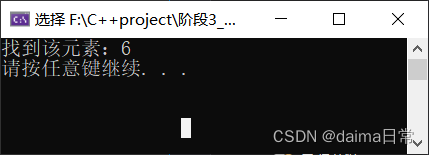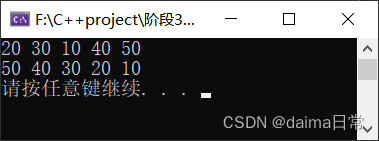文章目录
13 STL-函数对象
13.1 函数对象
13.1.1 函数对象概念
概念:
- 重载函数调用重载符的类,其对象常称为函数对象
- 函数对象使用重载的()时,行为类似函数调用,也叫仿函数
本质:
函数对象(仿函数)是一个类,不是一个函数
13.1.2 函数对象使用
特点:
- 函数对象在使用时,可以像普通函数那样调用,可以有参数,可以有返回值
- 函数对象超出普通函数的概念,函数对象可以有自己的状态
- 函数对象可以作为参数传递
示例代码:
#include<iostream>
using namespace std;
/*
* 函数对象(仿函数)
- 函数对象在使用时,可以像普通函数那样调用,可以有参数,可以有返回值
- 函数对象超出普通函数的概念,函数对象可以有自己的状态
- 函数对象可以作为参数传递
*/
class MyAdd
{
public:
int operator()(int v1, int v2)
{
return v1 + v2;
}
};
//1、函数对象在使用时,可以像普通函数那样调用,可以有参数,可以有返回值
void test11()
{
MyAdd myadd;
cout << myadd(10,20) << endl;
}
//2、 函数对象超出普通函数的概念,函数对象可以有自己的状态
class MyPrint
{
public:
MyPrint()
{
count = 0;
}
void operator()(string test)
{
cout << test << endl;
this->count++;
}
int count; //内部自己的状态
};
void test12()
{
MyPrint myprint;
myprint("hello world!");
myprint("hello world!");
myprint("hello world!");
cout << " MyPrint调用次数为:" << myprint.count << endl;
}
//3.函数对象可以作为参数传递
void doPrint(MyPrint& mp, string s)
{
mp(s);
}
void test13()
{
MyPrint mp;
doPrint(mp,"hello C++");
}
int main()
{
//test11();
//test12();
test13();
system("pause");
return 0;
}
运行结果:

总结:
- 仿函数写法非常灵活,可以作为参数进行传递
13.2 谓词
13.2.1 谓词概念
概念:
- 返回bool类型的仿函数称为谓词
- 如果operator() 接收一个参数,那么叫做一元谓词
- 如果operator()接受两个参数,那么叫做二元谓词
13.2.2 一元谓词
示例代码:
#include<iostream>
using namespace std;
#include<vector>
#include<algorithm>
//仿函数 返回值类型是bool数据类型,称为谓词
//一元谓词
class GreaterFive
{
public:
bool operator()(int v)
{
return v > 5;
}
};
void test21()
{
vector<int>v;
for (int i = 0; i < 10; i++)
{
v.push_back(i);
}
//查找容器中,有没有大于5的数字
//匿名的函数对象
vector<int>::iterator it= find_if(v.begin(), v.end(), GreaterFive());
if (it==v.end())
{
cout << "未找到" << endl;
}
else
{
cout << "找到该元素:" << (*it) << endl;
}
}
int main()
{
test21();
system("pause");
return 0;
}
运行结果:

总结: 参数只有一个的谓词,称为一元谓词
13.2.3 二元谓词
示例代码:
#include<iostream>
using namespace std;
#include<vector>
#include<algorithm>
//二元谓词
void printV(vector<int>&v)
{
for (vector<int>::iterator it = v.begin(); it != v.end(); it++)
{
cout << (*it) << " ";
}
cout << endl;
}
class MyCompare
{
public:
bool operator()(int v1, int v2)
{
return v1 > v2;
}
};
void test31()
{
vector<int>v;
v.push_back(20);
v.push_back(40);
v.push_back(10);
v.push_back(50);
v.push_back(30);
printV(v);
sort(v.begin(),v.end());
printV(v);
//使用函数对象,改变算法策略,变为排序规则从大到小
sort(v.begin(), v.end(), MyCompare());
printV(v);
}
int main()
{
test31();
system("pause");
return 0;
}
**运行结果:**

总结: 参数只有两个的谓词,称为二元谓词
13.3 内建函数对象
13.3.1 内建函数对象意义
概念:
- STL内建了一些函数对象
分类:
- 算术仿函数
- 关系仿函数
- 逻辑仿函数
用法:
- 这些仿函数所产生的对象,用法和一般函数完全相同
- 使用内建函数对象,需要引入头文件 #include
仿函数原型:
template<class T> T plus<T>//加法仿函数template<class T> T minus<T>//减法仿函数template<class T> T multiplies<T>//乘法仿函数template<class T> T divides<T>//除法仿函数template<class T> T modulus<T>//取模仿函数template<class T> T negate<T>//取反仿函数
示例代码:
#include<iostream>
using namespace std;
#include<functional> //内建函数对象头文件
//内建函数对象 算术仿函数
//negate 一元仿函数 取反仿函数
void test41()
{
negate<int>n;
cout << n(30) << endl;
}
//plus 二元仿函数 加法
void test42()
{
plus<int>p; //两个数必须是同类型,进行运算
cout << p(20, 80) << endl;
divides<int>d;
cout << d(100,10) << endl;
}
int main()
{
//test41();
test42();
system("pause");
return 0;
}
运行结果:

总结: 使用内建函数对象是,需要引入头文件 #include
13.3.2 关系仿函数
功能描述:
- 实现关系对比
仿函数原型:
template<class T> bool equal_to<T>//等于template<class T> bool not_equal_to<T>//不等于template<class T> bool greater<T>//大于template<class T> bool greater_equal<T>//大于等于template<class T> bool less<T>//小于template<class T> bool less_equal<T>//小于等于
示例代码:
#include<iostream>
using namespace std;
#include<vector>
#include<algorithm>
#include<functional>
//内建函数对象 关系仿函数
//大于 greater
class MyCompare
{
public:
bool operator()(int v1, int v2)
{
return v1 > v2;
}
};
void test01()
{
vector <int>v;
v.push_back(20);
v.push_back(30);
v.push_back(10);
v.push_back(40);
v.push_back(50);
for (vector<int>::iterator it = v.begin(); it != v.end(); it++)
{
cout << (*it) << " ";
}
cout << endl;
//sort(v.begin(),v.end(),MyCompare());
//greater<int>() 内建函数对象
sort(v.begin(),v.end(),greater<int>());
for (vector<int>::iterator it = v.begin(); it != v.end(); it++)
{
cout << (*it) << " ";
}
cout << endl;
}
int main()
{
test01();
system("pause");
return 0;
}
运行结果:

总结: 关系仿函数中最常用的就是greater<> 大于
13.3.3 逻辑仿函数
功能描述:
- 实现逻辑运算
函数原型:
template<class T> bool logical_and<T>//逻辑与template<class T> bool logical_or<T>//逻辑或template<class T> bool logical_not<T>//逻辑非
示例代码:
#include<iostream>
using namespace std;
#include<vector>
#include<algorithm>
#include<functional>
//内建函数对象 逻辑仿函数
//逻辑非 logical_not
void test61()
{
vector<bool>v;
v.push_back(true);
v.push_back(false);
v.push_back(false);
v.push_back(true);
for (vector<bool>::iterator it = v.begin(); it != v.end(); it++)
{
cout << (*it) << " ";
}
cout << endl;
//利用逻辑非,将容器v搬运到容器v2中,并执行取反操作
vector<bool>v2;
v2.resize(v.size()); //v2容器开辟与v一样的大小空间
transform(v.begin(), v.end(), v2.begin(), logical_not<bool>());
for (vector<bool>::iterator it = v2.begin(); it != v2.end(); it++)
{
cout << (*it) << " ";
}
cout << endl;
}
int main()
{
test61();
system("pause");
return 0;
}
运行结果:

总结: 逻辑仿函数实际应用较少,了解即可。
如果对你有帮助的话,请不要忘了给我一点点点…支持 ( ^ o ^)/~






















 9961
9961











 被折叠的 条评论
为什么被折叠?
被折叠的 条评论
为什么被折叠?








